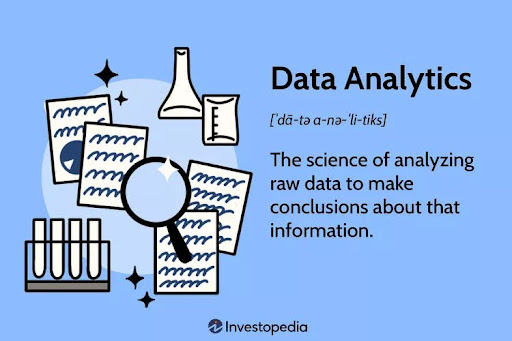Introduction
Data has become the backbone of modern strategies. Gone are the days when decisions were made based on gut feelings or intuition. Today, businesses rely on data to guide their actions, from marketing campaigns to product development and everything in between.
Data analytics, the process of analysing raw data to make informed decisions, plays a crucial role in this transformation. By harnessing the power of data, companies can uncover valuable insights, identify trends, and make decisions that drive growth.
This blog will explore how businesses can leverage data analytics for strategic growth, providing practical tips and real-world examples to help you get started.
1. What is Data Analytics? A Simple Breakdown
Data analytics is the practice of examining raw data to draw meaningful conclusions. In simple terms, it’s about turning numbers into actionable insights. The process involves collecting data, processing it to remove any noise or errors, and then analysing it to identify patterns, trends, and correlations.

Source: Investopedia
Imagine you’re a retail business owner. By analysing your sales data, you might notice that certain products sell better during specific times of the year. This insight lets you plan your inventory and marketing efforts more effectively, ensuring you have the right products available when your customers are most likely to buy.
There are different types of data analytics, each serving a unique purpose:
- Descriptive Analytics: This type summarises past data to understand what happened. For example, they analysed last quarter’s sales figures to see which products were most popular.
- Diagnostic Analytics: This goes a step further by examining why something happened. If sales dropped, diagnostic analytics might reveal that a competitor’s promotion coincided with the decline.
- Predictive Analytics: As the name suggests, this type uses historical data to predict future outcomes, such as sales trends based on past performance.
- Prescriptive Analytics: This is the most advanced type, offering recommendations on what actions to take. For instance, it suggested a specific marketing strategy based on predicted customer behaviour.
By understanding and utilising these types of data analytics, businesses can make informed decisions that lead to strategic growth.
2. The Importance of Data-Driven Decision Making
Relying on data rather than gut feelings or assumptions leads to better business decisions. Data-driven decision-making allows businesses to base their strategies on hard evidence, reducing the risk of costly mistakes.
One key benefit of data analytics is its better understanding of customer behaviour. For example, Netflix uses data analytics to recommend shows and movies based on users’ viewing habits, leading to higher customer satisfaction and retention. This personalised approach is a direct result of data-driven decision-making.
In addition to understanding customers, data analytics helps businesses stay ahead of market trends. Companies can identify emerging trends by analysing market data and adapting their strategies accordingly. For instance, during the COVID-19 pandemic, many companies used data analytics to shift their focus to online sales and digital marketing, ensuring they could continue to reach customers despite lockdowns and restrictions.
Moreover, data analytics is critical in reducing risks and uncovering new opportunities. For example, financial institutions use predictive analytics to assess credit risk, allowing them to make more informed lending decisions. Similarly, businesses can use data analytics to identify potential areas for growth, such as entering new markets or developing new products.
In a world with fierce competition and thin margins, data-driven decision-making provides a significant advantage, enabling businesses to make smarter, more strategic choices.
3. Key Areas Where Data Analytics Drives Business Growth
Data analytics can drive business growth in several key areas, helping companies to improve their operations, enhance customer satisfaction, and stay competitive in the market.
Customer Insights: Analyzing customer data is one of the most powerful ways to drive growth. By understanding customer preferences, behaviours, and pain points, businesses can create personalised marketing strategies that resonate with their audience. For example, Amazon’s recommendation engine, which suggests products based on past purchases and browsing history, has been a significant driver of its success. Personalised recommendations improve the customer experience and increase sales and customer loyalty.
Operational Efficiency: Data analytics can streamline operations by identifying inefficiencies and optimising processes. For instance, manufacturers can use data analytics to monitor production lines in real-time, identifying bottlenecks and making adjustments to improve productivity. Similarly, logistics companies can analyse delivery data to optimise routes, reduce fuel consumption, and lower costs.
Market Analysis: Understanding market trends is crucial for staying ahead. Data analytics allows businesses to track market conditions, monitor competitors, and identify growth opportunities.
For example, a company might discover a growing demand for eco-friendly products by analysing sales data and market trends. This insight could lead them to develop a new line of sustainable products, tapping into a lucrative market.
Product Development: Data analytics plays a vital role in product development by helping businesses understand what customers want and need. For example, by analysing customer feedback and usage data, companies can identify the most important features to users and focus on improving or expanding those areas. This approach not only leads to better products but also reduces the risk of investing in features or products that don’t resonate with customers.
In these areas, data analytics provides insights to help make informed decisions that drive growth and improve overall business performance.
4. Building a Data-Driven Culture in Your Organization
Building a data-driven culture within your organisation is essential to fully leveraging data analytics. This means fostering an environment where decisions are based on data and everyone understands the value of data in driving business success.
Educate and Train Employees: The first step in building a data-driven culture is to educate and train your employees. It’s essential that everyone in the organisation, from top executives to frontline staff, understands the basics of data analytics and how it can be used in their roles.
For example, marketing teams should be trained to analyse customer data to create targeted campaigns, while operations teams should learn to use data to optimise processes. Providing ongoing training and development opportunities will ensure your employees have the skills to leverage data effectively.
Integrate Data into Daily Operations: Data analytics must be integrated into daily operations to become a core part of your business. This means incorporating data analysis into regular business processes and decision-making.
For example, instead of making decisions based on intuition, encourage teams to analyse relevant data before taking action. This could involve using data dashboards to monitor key performance indicators (KPIs) in real time, ensuring that decisions are based on the most up-to-date information.
Use the Right Tools: The right tools are crucial for practical data analysis. Numerous data analytics tools are available, ranging from essential spreadsheet software to advanced business intelligence platforms.
Tools like Microsoft Power BI, Tableau, and Google Analytics are popular choices that offer powerful data visualisation and analysis capabilities. Tools like Excel or Google Sheets might be sufficient for smaller businesses. The key is to choose tools that are easy to use and fit your organisation’s specific needs.
Encourage Collaboration: Data-driven decision-making should not be confined to a single department. To maximise the benefits of data analytics, encourage cross-departmental collaboration.
For example, marketing, sales, and customer service teams can work together to analyse customer data and develop strategies to improve customer satisfaction and retention. By breaking down silos and promoting collaboration, you can ensure that data insights are shared across the organisation, leading to more informed and strategic decisions.
Building a data-driven culture takes time and effort, but the benefits are worth it. By making data analytics a central part of your business, you can drive growth, improve efficiency, and stay ahead of the competition.
5. Overcoming Common Challenges in Data Analytics
While data analytics offers significant benefits, implementing it effectively can be challenging. Here are some common challenges businesses face and how to overcome them:
Data Quality Issues: One of the biggest challenges in data analytics is ensuring that the data being analysed is accurate, complete, and reliable. Poor-quality data can lead to incorrect conclusions and bad decisions. To maintain data quality, it’s crucial to establish precise data collection, cleaning, and validation processes. Regular audits and quality checks can help identify and address issues before they impact decision-making. For example, a retail company might regularly review its sales data to ensure that all transactions are recorded correctly and that there are no discrepancies.
Lack of Skilled Personnel: Data analytics requires specialised skills, and many organisations need help finding or developing the talent needed to analyse and interpret data effectively. To bridge this talent gap, consider investing in training programs for existing employees or hiring data analysts with the necessary expertise. Partnering with educational institutions or offering internships can also help build a pipeline of skilled workers. Additionally, leveraging user-friendly data analytics tools can empower non-technical employees to perform fundamental data analysis, reducing the reliance on specialised personnel.
Resistance to Change: Shifting to a data-driven approach can be met with resistance from employees who are used to making decisions based on experience or intuition. Overcoming this resistance requires clear communication about the benefits of data analytics and how it can improve business outcomes. Involve employees by showing them how data can make their jobs easier and more effective.
For example, sales teams might initially resist using data analytics to guide their strategies. Still, they will likely embrace the change once they see how data can help them identify the most promising leads.
Privacy and Security Concerns: With the increasing amount of data being collected, managing privacy and security is a significant concern. Businesses must ensure that they comply with data protection regulations, such as the General Data Protection Regulation (GDPR) in Europe, and that they have robust security measures to protect sensitive information. Implementing data encryption, access controls, and regular security audits can help mitigate these risks.
Additionally, being transparent with customers about how their data is used and ensuring they have control over their information can build trust and reduce privacy concerns.
By addressing these challenges head-on, businesses can unlock the full potential of data analytics and use it to drive strategic growth.
6. Real-World Case Studies: Success Stories in Data Analytics
To illustrate the power of data analytics in driving business growth, let’s look at a couple of real-world success stories:
Case Study 1: Starbucks: Starbucks is a prime example of a company successfully leveraging data analytics to enhance its business strategy. By analysing customer data, Starbucks developed its loyalty program, which offers personalised rewards based on customers’ purchasing habits. This data-driven approach has helped Starbucks increase customer engagement and loyalty, leading to higher sales and a stronger brand presence.
Case Study 2: Netflix: Netflix is another company that has made data analytics a core business strategy. By analysing viewing data, Netflix can recommend content tailored to individual preferences, resulting in a more personalised user experience. This approach has been incredibly successful, helping Netflix retain subscribers and reduce churn. Additionally, Netflix uses data analytics to inform its content production decisions, ensuring that it invests in shows and movies likely to be popular with its audience.
These case studies demonstrate how data analytics can lead to tangible business results, from increased customer loyalty to more informed strategic decisions.
7. Future Trends in Data Analytics: What’s Next?
As technology continues to evolve, so does the data analytics field. Here are some emerging trends that are likely to shape the future of data analytics and further enhance its role in business growth:
AI-Powered Analytics: Artificial intelligence (AI) is increasingly integrated into data analytics, allowing for more sophisticated analysis and faster insights. AI-powered analytics can automate the analysis of large datasets, identifying patterns, and making predictions. For example, AI can analyse customer sentiment on social media, providing businesses real-time feedback on their brand reputation. As AI advances, we expect to see even more powerful analytics tools that can process complex data and generate actionable insights with minimal human intervention.
Real-Time Data Processing: The demand for real-time data processing is growing, driven by the need for businesses to make quick decisions in a fast-paced environment. Real-time analytics allows businesses to monitor key metrics as they happen, enabling them to respond to changes and opportunities immediately. For example, e-commerce companies can use real-time analytics to track website traffic and sales, allowing them to adjust marketing campaigns or promotions on the fly. As real-time data processing becomes more accessible, it will become an essential tool for businesses looking to stay agile and competitive.
Data Democratization: The trend towards democratisation is making data analytics more accessible to non-technical users. With the development of user-friendly analytics tools and platforms, employees across all departments can now access and analyse data without needing specialised skills. This democratisation of data empowers more people within an organisation to make data-driven decisions, leading to more informed and cohesive strategies. For example, sales teams can use data analytics tools to analyse customer data and identify trends without relying on a dedicated data analyst.
Enhanced Data Visualization: Data visualisation tools are becoming more advanced, allowing businesses to present complex data more intuitively and understandably. Enhanced data visualisation helps stakeholders quickly grasp insights and make informed decisions. For example, interactive dashboards can display key performance indicators (KPIs) in a visually appealing format, making it easier for executives to track business performance and identify areas for improvement.
By staying updated with these trends, businesses can continue to benefit from data analytics and use it to drive strategic growth in an increasingly competitive market.
Conclusion
Data analytics has become an indispensable tool for businesses seeking strategic growth. From understanding customer behaviour to optimising operations and developing new products, data analytics provides the insights needed to make informed decisions and stay ahead of the competition.
As we’ve seen, building a data-driven culture, addressing common challenges, and staying updated with the latest trends are all crucial for effectively leveraging data analytics. Whether you’re a small business or a large corporation, the key to success lies in harnessing the power of data to guide your strategy.
If you haven’t already, now is the time to start or continue leveraging data analytics in your business. Explore the tools and techniques available, train your employees, and integrate data into your daily operations. Doing so, you’ll be well-positioned to drive growth and achieve your business goals in today’s data-driven world.




